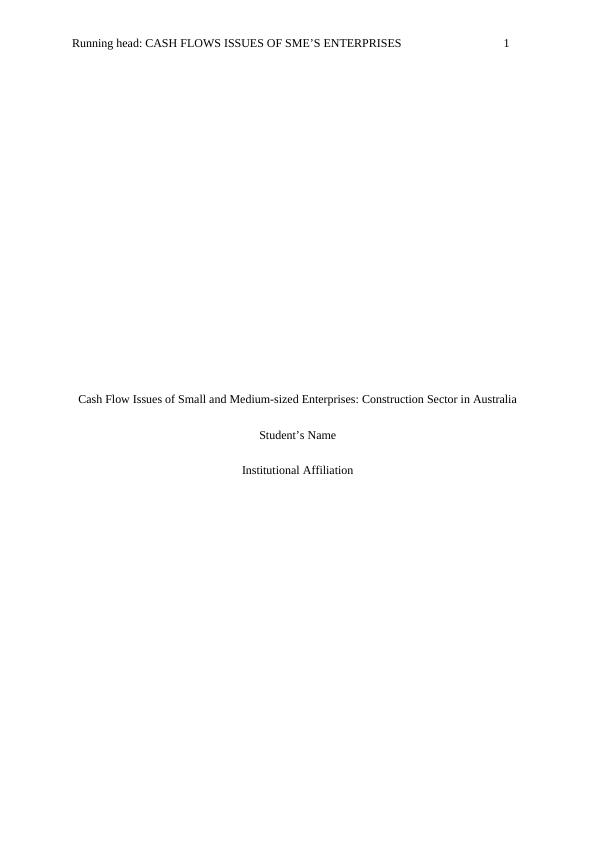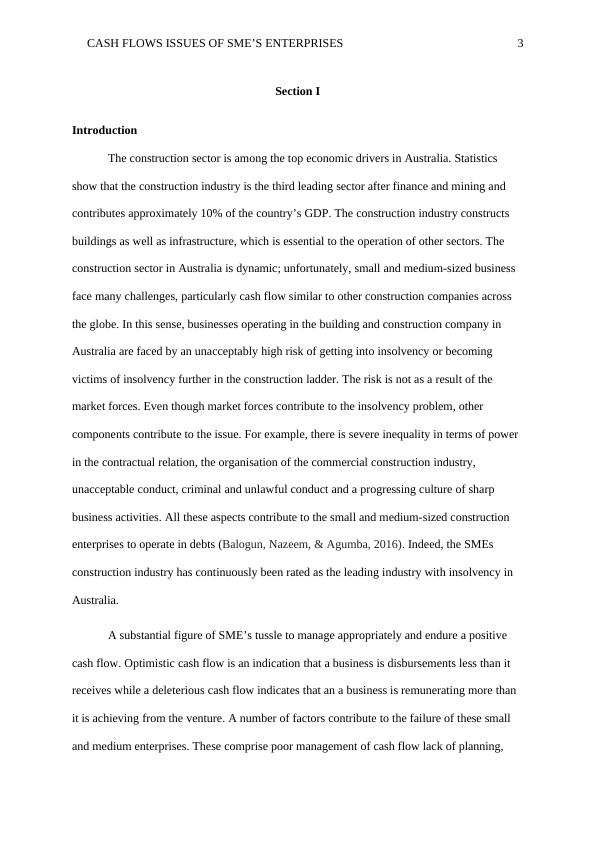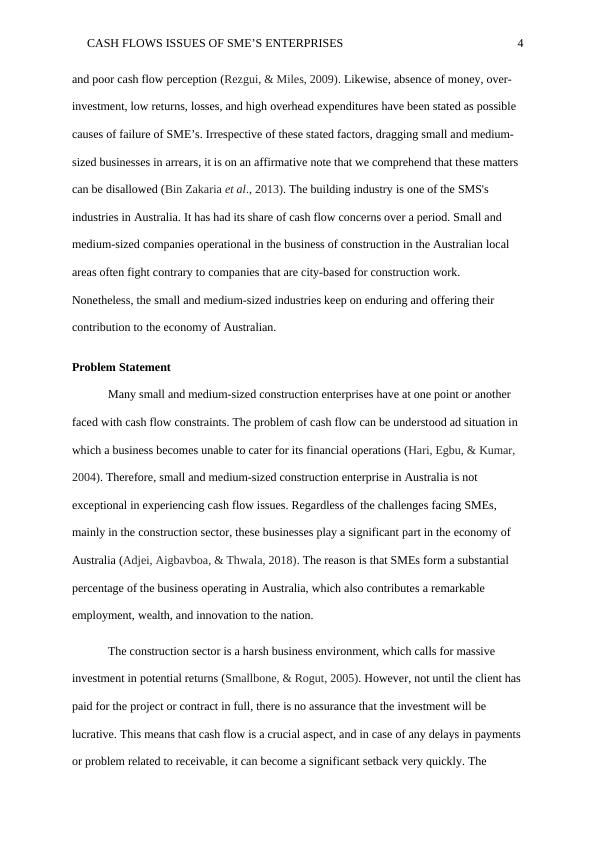Cash Flow Issues of SME's Enterprises: Construction Sector in Australia
Advanced qualitative data analysis methods in business research
21 Pages4083 Words438 Views
Added on 2023-03-30
About This Document
This research proposal focuses on the cash flow issues faced by small and medium-sized construction enterprises in Australia. It discusses the challenges faced by these enterprises, such as slow invoicing and payment cycles, increasing costs of raw materials, lack of safety training and shortage of skilled labor. The proposal aims to determine the impact of these cash flow issues on the construction industry and the economy of Australia as a whole. It also aims to identify strategies that can be used to resolve these issues and improve cash flow management in SMEs. The research questions and objectives are outlined, and the expected outcomes of the research are discussed.
Cash Flow Issues of SME's Enterprises: Construction Sector in Australia
Advanced qualitative data analysis methods in business research
Added on 2023-03-30
ShareRelated Documents
Running head: CASH FLOWS ISSUES OF SME’S ENTERPRISES 1
Cash Flow Issues of Small and Medium-sized Enterprises: Construction Sector in Australia
Student’s Name
Institutional Affiliation
Cash Flow Issues of Small and Medium-sized Enterprises: Construction Sector in Australia
Student’s Name
Institutional Affiliation

CASH FLOWS ISSUES OF SME’S ENTERPRISES 2
Table of Contents
Section I................................................................................................................................................3
Introduction...........................................................................................................................................3
Problem Statement................................................................................................................................4
Research Objective and Questions........................................................................................................5
Research questions............................................................................................................................5
Justification of Project...........................................................................................................................6
Expected Research Outcome.................................................................................................................7
Section II...............................................................................................................................................8
Conceptual Framework and Research Hypothesis.................................................................................8
Challenges Facing the SMEs Construction Industry..........................................................................8
Slow invoicing and payment cycles...............................................................................................8
Increasing costs of raw materials...................................................................................................9
Lack of safety training and shortage of skilled labor.....................................................................9
Inadequate planning.....................................................................................................................10
Undercapitalisation......................................................................................................................11
Hypothesis Development.................................................................................................................11
Methodology.......................................................................................................................................12
Research approach and sources of data............................................................................................12
Literature review.............................................................................................................................13
Proposed data collection and analysis techniques............................................................................13
Population....................................................................................................................................13
Sampling......................................................................................................................................13
Variables and analysis.................................................................................................................14
Section III............................................................................................................................................15
The organisation of Study....................................................................................................................15
Gantt Chart..........................................................................................................................................15
Project Budget and Budget Justification..............................................................................................16
References...........................................................................................................................................18
Table of Contents
Section I................................................................................................................................................3
Introduction...........................................................................................................................................3
Problem Statement................................................................................................................................4
Research Objective and Questions........................................................................................................5
Research questions............................................................................................................................5
Justification of Project...........................................................................................................................6
Expected Research Outcome.................................................................................................................7
Section II...............................................................................................................................................8
Conceptual Framework and Research Hypothesis.................................................................................8
Challenges Facing the SMEs Construction Industry..........................................................................8
Slow invoicing and payment cycles...............................................................................................8
Increasing costs of raw materials...................................................................................................9
Lack of safety training and shortage of skilled labor.....................................................................9
Inadequate planning.....................................................................................................................10
Undercapitalisation......................................................................................................................11
Hypothesis Development.................................................................................................................11
Methodology.......................................................................................................................................12
Research approach and sources of data............................................................................................12
Literature review.............................................................................................................................13
Proposed data collection and analysis techniques............................................................................13
Population....................................................................................................................................13
Sampling......................................................................................................................................13
Variables and analysis.................................................................................................................14
Section III............................................................................................................................................15
The organisation of Study....................................................................................................................15
Gantt Chart..........................................................................................................................................15
Project Budget and Budget Justification..............................................................................................16
References...........................................................................................................................................18

CASH FLOWS ISSUES OF SME’S ENTERPRISES 3
Section I
Introduction
The construction sector is among the top economic drivers in Australia. Statistics
show that the construction industry is the third leading sector after finance and mining and
contributes approximately 10% of the country’s GDP. The construction industry constructs
buildings as well as infrastructure, which is essential to the operation of other sectors. The
construction sector in Australia is dynamic; unfortunately, small and medium-sized business
face many challenges, particularly cash flow similar to other construction companies across
the globe. In this sense, businesses operating in the building and construction company in
Australia are faced by an unacceptably high risk of getting into insolvency or becoming
victims of insolvency further in the construction ladder. The risk is not as a result of the
market forces. Even though market forces contribute to the insolvency problem, other
components contribute to the issue. For example, there is severe inequality in terms of power
in the contractual relation, the organisation of the commercial construction industry,
unacceptable conduct, criminal and unlawful conduct and a progressing culture of sharp
business activities. All these aspects contribute to the small and medium-sized construction
enterprises to operate in debts (Balogun, Nazeem, & Agumba, 2016). Indeed, the SMEs
construction industry has continuously been rated as the leading industry with insolvency in
Australia.
A substantial figure of SME’s tussle to manage appropriately and endure a positive
cash flow. Optimistic cash flow is an indication that a business is disbursements less than it
receives while a deleterious cash flow indicates that an a business is remunerating more than
it is achieving from the venture. A number of factors contribute to the failure of these small
and medium enterprises. These comprise poor management of cash flow lack of planning,
Section I
Introduction
The construction sector is among the top economic drivers in Australia. Statistics
show that the construction industry is the third leading sector after finance and mining and
contributes approximately 10% of the country’s GDP. The construction industry constructs
buildings as well as infrastructure, which is essential to the operation of other sectors. The
construction sector in Australia is dynamic; unfortunately, small and medium-sized business
face many challenges, particularly cash flow similar to other construction companies across
the globe. In this sense, businesses operating in the building and construction company in
Australia are faced by an unacceptably high risk of getting into insolvency or becoming
victims of insolvency further in the construction ladder. The risk is not as a result of the
market forces. Even though market forces contribute to the insolvency problem, other
components contribute to the issue. For example, there is severe inequality in terms of power
in the contractual relation, the organisation of the commercial construction industry,
unacceptable conduct, criminal and unlawful conduct and a progressing culture of sharp
business activities. All these aspects contribute to the small and medium-sized construction
enterprises to operate in debts (Balogun, Nazeem, & Agumba, 2016). Indeed, the SMEs
construction industry has continuously been rated as the leading industry with insolvency in
Australia.
A substantial figure of SME’s tussle to manage appropriately and endure a positive
cash flow. Optimistic cash flow is an indication that a business is disbursements less than it
receives while a deleterious cash flow indicates that an a business is remunerating more than
it is achieving from the venture. A number of factors contribute to the failure of these small
and medium enterprises. These comprise poor management of cash flow lack of planning,

CASH FLOWS ISSUES OF SME’S ENTERPRISES 4
and poor cash flow perception (Rezgui, & Miles, 2009). Likewise, absence of money, over-
investment, low returns, losses, and high overhead expenditures have been stated as possible
causes of failure of SME’s. Irrespective of these stated factors, dragging small and medium-
sized businesses in arrears, it is on an affirmative note that we comprehend that these matters
can be disallowed (Bin Zakaria et al., 2013). The building industry is one of the SMS's
industries in Australia. It has had its share of cash flow concerns over a period. Small and
medium-sized companies operational in the business of construction in the Australian local
areas often fight contrary to companies that are city-based for construction work.
Nonetheless, the small and medium-sized industries keep on enduring and offering their
contribution to the economy of Australian.
Problem Statement
Many small and medium-sized construction enterprises have at one point or another
faced with cash flow constraints. The problem of cash flow can be understood ad situation in
which a business becomes unable to cater for its financial operations (Hari, Egbu, & Kumar,
2004). Therefore, small and medium-sized construction enterprise in Australia is not
exceptional in experiencing cash flow issues. Regardless of the challenges facing SMEs,
mainly in the construction sector, these businesses play a significant part in the economy of
Australia (Adjei, Aigbavboa, & Thwala, 2018). The reason is that SMEs form a substantial
percentage of the business operating in Australia, which also contributes a remarkable
employment, wealth, and innovation to the nation.
The construction sector is a harsh business environment, which calls for massive
investment in potential returns (Smallbone, & Rogut, 2005). However, not until the client has
paid for the project or contract in full, there is no assurance that the investment will be
lucrative. This means that cash flow is a crucial aspect, and in case of any delays in payments
or problem related to receivable, it can become a significant setback very quickly. The
and poor cash flow perception (Rezgui, & Miles, 2009). Likewise, absence of money, over-
investment, low returns, losses, and high overhead expenditures have been stated as possible
causes of failure of SME’s. Irrespective of these stated factors, dragging small and medium-
sized businesses in arrears, it is on an affirmative note that we comprehend that these matters
can be disallowed (Bin Zakaria et al., 2013). The building industry is one of the SMS's
industries in Australia. It has had its share of cash flow concerns over a period. Small and
medium-sized companies operational in the business of construction in the Australian local
areas often fight contrary to companies that are city-based for construction work.
Nonetheless, the small and medium-sized industries keep on enduring and offering their
contribution to the economy of Australian.
Problem Statement
Many small and medium-sized construction enterprises have at one point or another
faced with cash flow constraints. The problem of cash flow can be understood ad situation in
which a business becomes unable to cater for its financial operations (Hari, Egbu, & Kumar,
2004). Therefore, small and medium-sized construction enterprise in Australia is not
exceptional in experiencing cash flow issues. Regardless of the challenges facing SMEs,
mainly in the construction sector, these businesses play a significant part in the economy of
Australia (Adjei, Aigbavboa, & Thwala, 2018). The reason is that SMEs form a substantial
percentage of the business operating in Australia, which also contributes a remarkable
employment, wealth, and innovation to the nation.
The construction sector is a harsh business environment, which calls for massive
investment in potential returns (Smallbone, & Rogut, 2005). However, not until the client has
paid for the project or contract in full, there is no assurance that the investment will be
lucrative. This means that cash flow is a crucial aspect, and in case of any delays in payments
or problem related to receivable, it can become a significant setback very quickly. The

CASH FLOWS ISSUES OF SME’S ENTERPRISES 5
construction industry in Australia is diverse and healthy; nonetheless, it experiences
challenges here and there like other construction companies across the globe (Khan,
Flanagan, & Lu, 2015). For example, the increasing cost of raw material is a standard
pressure, which demands that contractors should seek for novel strategies to cope with the
rising cost and at the same time keep their rates competitive. In light of this statement, the
cash flow issues facing small and medium-sized construction enterprises directly affects the
economy of Australia; hence there is need to address the issue to resolve the problem to save
the country’s economy.
Research Objective and Questions
The main objective of this project is to explore and apprehend the economic
encounters faced by SMEs in the construction sector in Australia in relation to cash flow,
capital, and aid for development. It is significant to appreciate these features because it is the
only technique to resolve them and save the involvement made by the construction commerce
to the economy of Australia. The objective of this research proposal include:
To determine how cash flow problems have impacted the construction industry and
the economy of Australian at large.
To determine the strategies that can be used to resolve the cash flow problem faced by
SMEs in the construction industry.
To determine the cause of the cash flow problem facing small and medium-sized
construction companies in Australia.
Research questions
The research proposal will use the following research questions that will act as the
compass direction while undertaking the research regarding the topic under investigation.
construction industry in Australia is diverse and healthy; nonetheless, it experiences
challenges here and there like other construction companies across the globe (Khan,
Flanagan, & Lu, 2015). For example, the increasing cost of raw material is a standard
pressure, which demands that contractors should seek for novel strategies to cope with the
rising cost and at the same time keep their rates competitive. In light of this statement, the
cash flow issues facing small and medium-sized construction enterprises directly affects the
economy of Australia; hence there is need to address the issue to resolve the problem to save
the country’s economy.
Research Objective and Questions
The main objective of this project is to explore and apprehend the economic
encounters faced by SMEs in the construction sector in Australia in relation to cash flow,
capital, and aid for development. It is significant to appreciate these features because it is the
only technique to resolve them and save the involvement made by the construction commerce
to the economy of Australia. The objective of this research proposal include:
To determine how cash flow problems have impacted the construction industry and
the economy of Australian at large.
To determine the strategies that can be used to resolve the cash flow problem faced by
SMEs in the construction industry.
To determine the cause of the cash flow problem facing small and medium-sized
construction companies in Australia.
Research questions
The research proposal will use the following research questions that will act as the
compass direction while undertaking the research regarding the topic under investigation.

CASH FLOWS ISSUES OF SME’S ENTERPRISES 6
1. In what ways has the issue of cash flow affected the construction industry and the
economy of Australia as a whole?
2. Which strategies can be used to help resolve the cash flow issues faced by the SMEs
in the construction industry?
3. What is the cause of the cash flow problem facing small and medium-sized
construction companies in Australia?
Justification of the Project
Research about the cash flow issues facing small and medium-sized business in the
construction sector is essential to the economy of Australia because of the following reasons:
To begin with, small and medium-sized construction companies are vital contributors to the
economy of Australia, employing many Australians. Statistics by the Reserve Bank of
Australia (RBA) show that SMEs has offered employment to nearly 70% of the Australian
labor force. In this sense, it means that small and medium-sized construction companies have
contributed that percentage too. Indeed, small and medium-sized enterprises in most cases,
provide a lot of employment to opportunities to unskilled people, which aid in driving down
the rate of unemployment. Accordingly, this will be a constructive flow-on effect like the
decline in welfare dependency, reduced rate of crime, and improved living standards, among
others (Karadag, 2015).
Secondly, small and medium-sized construction enterprises are critical to the
economy as well as the business landscape in general because it is a source of novelty for a
business that operates within this industry. So that to keep up as well as compete effectively
with big construction companies that have sufficient resources, SMEs innovate to gain a
competitive edge. The novelty in small and medium-sized enterprises in the construction
1. In what ways has the issue of cash flow affected the construction industry and the
economy of Australia as a whole?
2. Which strategies can be used to help resolve the cash flow issues faced by the SMEs
in the construction industry?
3. What is the cause of the cash flow problem facing small and medium-sized
construction companies in Australia?
Justification of the Project
Research about the cash flow issues facing small and medium-sized business in the
construction sector is essential to the economy of Australia because of the following reasons:
To begin with, small and medium-sized construction companies are vital contributors to the
economy of Australia, employing many Australians. Statistics by the Reserve Bank of
Australia (RBA) show that SMEs has offered employment to nearly 70% of the Australian
labor force. In this sense, it means that small and medium-sized construction companies have
contributed that percentage too. Indeed, small and medium-sized enterprises in most cases,
provide a lot of employment to opportunities to unskilled people, which aid in driving down
the rate of unemployment. Accordingly, this will be a constructive flow-on effect like the
decline in welfare dependency, reduced rate of crime, and improved living standards, among
others (Karadag, 2015).
Secondly, small and medium-sized construction enterprises are critical to the
economy as well as the business landscape in general because it is a source of novelty for a
business that operates within this industry. So that to keep up as well as compete effectively
with big construction companies that have sufficient resources, SMEs innovate to gain a
competitive edge. The novelty in small and medium-sized enterprises in the construction

End of preview
Want to access all the pages? Upload your documents or become a member.
Related Documents
Cash Flow Management in Australian SMEslg...
|18
|4045
|5604
Construction Financial Managementlg...
|9
|2834
|500
Influence of Accounting Practices in Small and Medium Enterpriseslg...
|13
|3433
|424
Factors Affecting Performance of Small and Medium Enterprises Assignmentlg...
|17
|3397
|48
Strategy Development for Small and Medium Enterprises (SMEs)lg...
|19
|6813
|215
(PDF) The Role of Banks in Small and Medium Enterpriseslg...
|18
|3504
|285
